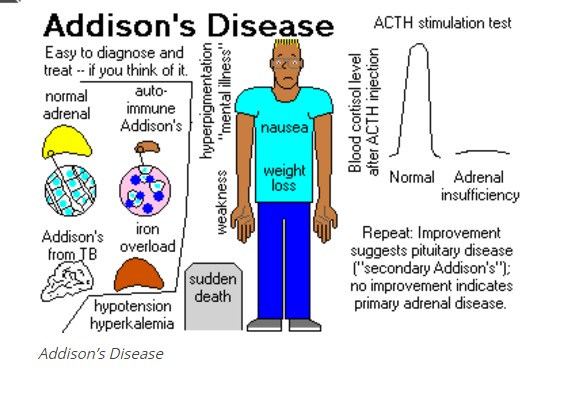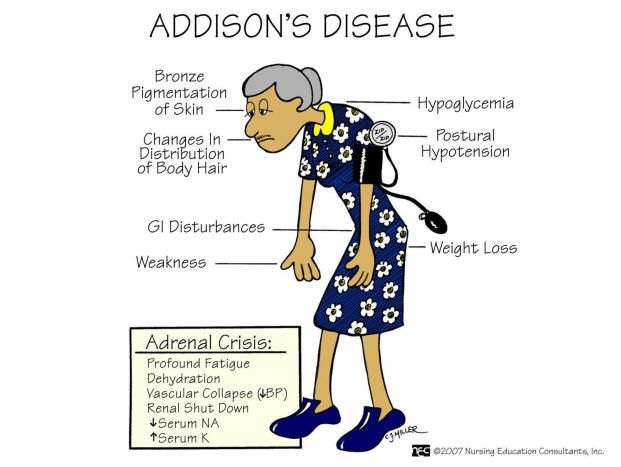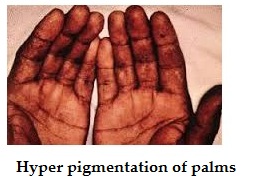Addison's Disease
Definition
Adrenocortical Insufficiency
Inadequate functioning of adrenal cortex
Aetiology
Autoimmune or idiopathic atrophy of the adrenal glands is responsible.
Other causes : surgical removal of bothadrenal glands or infection of the adrenal glands byTuberculosis / and histoplasmosis
adrenal gland tissue.
Autoimmune destruction
Inadequate secretion of ACTH from the pituitary gland.
Sudden cessation of Therapeutic use of corticosteroids.
Clinical Manifestations
Muscle weakness,
Anorexia,
Gastrointestinal symptoms,
Fatigue
Emaciation
Dark pigmentation of the skin, knuckles, knees, elbows, and mucous membranes,
Hypotension
Low blood glucose levels
Low serum sodium levels, and high serum potassium levels.
Depression, emotional lability, apathy, and confusion
In severe cases, chronic dehydration.
Addisonian crisis : which is characterized by cyanosis and circulatory shock: pallor, apprehension, rapidand weak pulse, rapid respirations, and low blood pressure
Headache, nausea, abdominal pain, and diarrhea and show signs of
Confusion and restlessness.
Even slight overexertion, exposure to cold, acute infections, or a decrease in salt intake may lead to circulatory collapse, shock, and death if untreated.
The stress of surgery or dehydration resulting from preparation for diagnostic tests or surgery may precipitate an addisonian or hypotensive crisis.
Laboratory Findings
Decreased blood glucose (hypoglycemia)
Hyponatremia
Hyperkalemia
Leukocytosis
Decreased adrenocortical hormones in the blood or urine
Decreased serum cortisol levels
ACTH stimulation test : if cortex is destroyed no response and if normal rise of plasma cortisol and urinary 17-Hydroxycorticosteroids
Medical Managment
Steroids
If shock+ : combat shock with IV fluids,
Corticosteroids (Hydrocortisone - Effcorlin) bolus and then maintenance dose through 5% destrose
Vasopressor amines if hypotension persists.
Antibiotics for infection
Switch over to oral dosage
Life long treatment with steroids may be needed.
Nursing in Addison's disease
Monitor pulse BP RR weakness, weight of the patient - a decrease in systolic BP of 20 or more may indicate a depletion of fluid volume
Exposure to cold, overexertion, infection and emotional stress avoided.
IV fluids, electolytes, steroid hormones and vasopressors
Identify the stress factor and teach patient to avoid it.
Monitor hydration
Assist the patient to select high sodium diet during hot weather and GIT disturbances
Give written instructions to the patient and family regarding regarding administrationo of mineralocorticoids or corticosteroids
Teach to avoid unnecessary exertions
Build up activity tolerence
Promote home and community based care : give preloaded, single injection syringes
Make the patient wear a medical alert bracelet
* * * * * * * * * * * *






